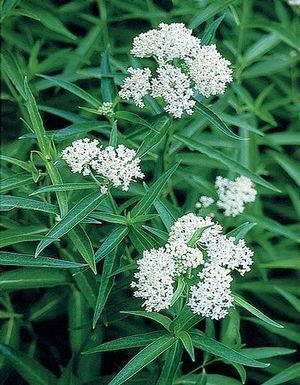New Moon Nurseries

A white selection of swamp milkweed, which thrives in wet habitats such as marshes, floodplains, lakes, and ponds.
Asclepias incarnata 'Ice Ballet'
Swamp milkweed
Native to North America (cultivar)
FIRST IMPRESSIONS: This elegant plant is upright with slender willow like leaves. In summer plants are topped by clear white flower clusters which attract flocks of butterflies. Plants thrive in sunny sites with moist or saturated soils. The ‘Ice Ballet’ cultivar differs from the species due to its white flowers, more compact habit and darker green foliage.
HABITAT & HARDINESS: ‘Asclepias incarnata ‘Ice Ballet’ is a nursery selection of the native Swamp Milkweed so it does not exist in the wild.
Plants are hardy from USDA Zones 3-9.
PLANT DESCRIPTION: This Swamp Milkweed cultivar is an erect clump forming perennial that grows from a taproot.
Plants have narrow lance shaped leaves with pointed tips and smooth margins. Stems and leaves contain a milky sap that exudes when plants are damaged. Desirable yellow and black Monarch caterpillars feed on the foliage.
Fragrant summer umbels are composed of many tiny star shaped florets. The intricate florets look like freshly extruded white cake decorations. Butterflies, bees and moths seek the floral nectar.
After flowering 4” seed pods split and release brown seed with silken parachutes that drift away on the wind.
Plants are more compact than the species growing about 3’ tall with 2-3’ spread.
CULTURAL & MAINTENANCE NEEDS: Asclepias incarnata ‘Ice Ballet’ is a sun loving plant for moist or saturated soils.
It is almost impossible to grow milkweed without a throng of oleander aphids in residence. These tiny orange plant lice suck the plant’s sugary sap and exude sticky honeydew that is the perfect cultural medium for black sooty mold. All phases and consequences of the oleander aphid life cycle are alarming to gardeners. The actual damage to the plant, however, is usually minimal and no treatment is needed.
Milkweeds are not palatable to deer, rabbits and other herbivores.
LANDSCAPE USES: Asclepias incarnata ‘Ice Ballet’ is a great choice for a well drained Perennial Border or a garden with a difficult sunny wet microclimate. Plants are also used as an Accent, Butterfly Nectar Plant, Butterfly Host Plant or as part of a Grouping or Mass Planting. It provides Fragrance and Showy Blooms and is useful in Cottage Gardens, Deer Resistant Plantings and Low Maintenance Plantings.
COMPANION & UNDERSTUDY PLANTS: Asclepias incarnata ‘Ice Ballet’ mingles well with other sun & moisture lovers like Eupatorium fistulosum, Lobelia cardinalis, Helianthus angustifolia, Eupatorium colestinum and Aster novae-angliae.
The Asclepias incarnata species can be substituted if needed.
TRIVIA: Milkweed sap contains bitter tasting and toxic cardiac glycosides. These chemicals accumulate in the bodies of Monarch caterpillars and function as a safeguard against predators. High toxin concentrations make the caterpillar more poisonous and impart more protection. Usually Monarch caterpillars and other milkweed foragers develop a bright warning color that may be interpreted as “If you eat me, you’ll die!”
All sorts of undesirable bugs (like the oleander aphid) love the milkweeds. If this is an issue, conventional pesticide treatments should be avoided because they will usually kill the highly desirable Monarch Butterfly caterpillar.
Height:
3-4 ftSpread:
2-3 inSpacing:
3-4 ftUSDA Hardiness Zone:
3-9Bloom Color:
WhiteAsclepias incarnata 'Ice Ballet' Characteristics
Attracts Wildlife
- Pollinators
- Butterflies
Attributes
- Rain Garden
- East-Coast Native
- Dried Flower
- Cut Flower
- Bog
- Naturalizing
- Fragrant
Exposure
- Full Sun
Flowering Months
- August
- July
Foliage Color
- Green
Salt Tolerance
- Medium
Soil Moisture Preference
- Wet to Moist